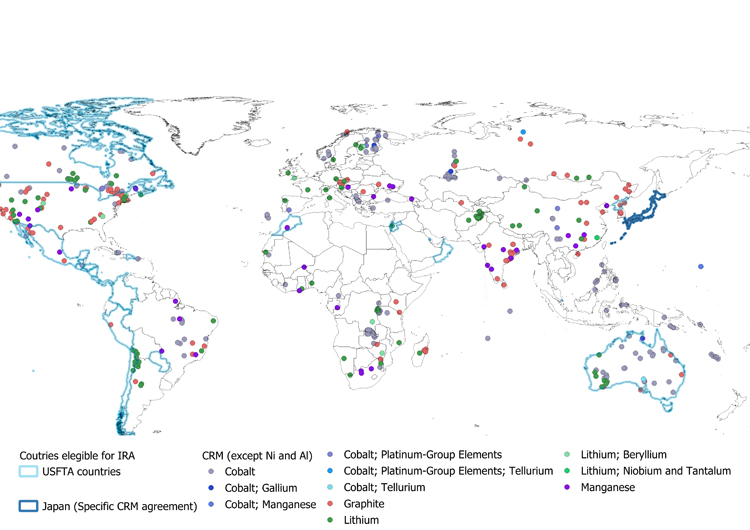By Chaya Dissanayake and Rashmi Anupama
- The increasing desire for Electrical Vehicles will increase the demand from customers for both of those artificial and all-natural graphite, notably non-Chinese graphite, with the introduction of the US’ Inflation Reduction Act (IRA).
- Substantial-high-quality Sri Lankan vein graphite, licensed as environmentally sustainable with the “green” label, will solidify its standing in the world-wide market.
- Linking with global companions to shift to the manufacture of benefit-included solutions can improve Sri Lanka’s benefits from the graphite marketplace.
The world demand from customers for Electric Automobiles (EVs) is projected to achieve a staggering 80 million models by 2050, with the United States (US) alone envisioned to demand a single million of these per year. This climbing worldwide desire will guide to a hike in the want for normal and synthetic graphite. Thinking of the US imposing limits on Chinese imports, non-Chinese graphite suppliers, which includes Sri Lanka stand to achieve.
A new IPS research underscores Sri Lanka’s comparative edge in graphite exports regardless of its at the moment modest output and fairly bigger selling prices for vein graphite in comparison to China. The review indicates transferring in the direction of a totally free trade arrangement/ mineral trade settlement for exporting graphite, particularly with US partners would be perfect for Sri Lanka to leverage the benefits from the US’ Inflation Reduction Act (IRA). The publication of this research titled ‘Trade Wars in Electric Vehicle Offer Chains: A Acquire for Sri Lanka’s Graphite Market?’ by IPS researchers Dr Asanka Wijesinghe, Malisha Weerasinghe and Chaya Dissanayake at IPS not long ago featured an engaging dialogue with vital figures in Sri Lanka’s mineral and EV element production market. This write-up is based mostly on the discussion highlighting implications and opportunities for the country’s graphite business.
Technological Competitiveness and Sri Lanka’s Strategic Situation
Professor Anura Wijayapala, an eminent electrical engineer from the College of Moratuwa and a previous director of the Ceylon Energy Board (2015-2017) pointed out that Sri Lanka’s strategic edge lies in upstream worth chain items (price-added goods) within just the EV marketplace. The existing graphite written content of Sri Lanka is all around 1.5 Mn tonnes, which is not suitable to meet up with the US demand from customers. He stated that Sri Lanka could profit from the high marketplace rates for graphite by branding Sri Lankan graphite as greater top quality and produced by means of environmentally pleasant and sustainable techniques.
Even with the IRA, Chinese electrical cells will prevail in the international sector. As the IPS examine reveals, China dominates all the nodes in EV automobile generation. Sri Lanka could as a substitute profit from partnering with ASEAN nations around the world wherever other Significant Uncooked Components (CRMs) are uncovered and who have Cost-free Trade Agreements (FTAs) with the US. Another alternative is to deliver graphite or anodes for the Indian EV industry.
Determine 1: Distribution of critical minerals employed in EV battery manufacturing excepting Nickel and Aluminum metals and the nations around the world which are eligible for concessions beneath US IRA
Resource: Authors’ compilation
Lowering Expenses and Maximizing Generation
Mr Amila Jayasinghe, CEO, Bogala Graphite PLC shared that the existing higher charges of Sri Lankan graphite are because of to the depth of the deposits in the couple of operational mines inside the nation. Lessening the depth of procedure to 10-20 m from the floor could significantly decrease the cost of mining, which can be accomplished by expanding mining operations to new mines, supplied ample restrictions are in location.
Challenges this sort of as the transparency of the system to receive mining permissions from suitable authorities discourage possible overseas financial commitment. The royalty fee for worth-additional graphite in Sri Lanka encourages the export of uncooked graphite to international anode producers as it is less costly, which is not valuable to the nearby producer.
Determine 2: Recognized graphite deposits in Sri Lanka and destinations of active graphite mines

Resource: Authors’ compilation
Govt Initiatives to Website link Sri Lanka to Global Value Chain
Mr Akila de Zoysa, Deputy Director of Export Providers at the Export Progress Board of Sri Lanka (EDB), talked about govt initiatives to hyperlink regional manufacturers with global worth chains, highlighting the prospective of graphite worth addition. For illustration, graphene generation, which is extracted from graphite, has a better sector benefit and need. Nevertheless, graphene output is highly-priced and needs investments to produce into a financially rewarding sector.
On a favourable be aware, a multinational business with Sri Lankan origins options to start an EV battery assembly plant in Sri Lanka in partnership with a Swedish corporation. The EDB is exploring the possibility of connecting area graphite production businesses with this company for the battery production course of action. On top of that, there are numerous local corporations which are now assembling EV motor vehicles with much more than 35% value addition inside of the place.
World-wide Implications and Tapping into Inexperienced Technological innovation
Relocation of industries to other nations in the aftermath of the economic disaster would make it hard to attract new investments. There are also geopolitical considerations to moving into into a CRM arrangement with the US specified the latest hostilities concerning China and the US. On the other hand, Sri Lanka can circumvent theses complications by cooperating with Vietnam or Southeast Asian nations with FTAs with the US. Alternatively negotiating a thorough CRM agreement with the US on graphite exports like the US-Japan CRM settlement may possibly also deliver a far more diplomatic avenue to income from IRA.
Sri Lankan graphite output is comparatively a green process. Specified other producing industries in Sri Lanka are presently making use of renewable electrical power utilization to current market their goods to environmentally conscious buyers. About 50 % of Sri Lanka’s electricity is renewable and the greenhouse fuel emission in Sri Lanka is also comparatively very low when compared to a lot of other international locations which may assistance label Sri Lanka’s graphite as “green graphite”.
Results for the Sri Lankan graphite sector hinges on aggressive positioning, strategic international partnerships, and green production procedures. As the electric powered car or truck marketplace proceeds to extend, Sri Lanka’s graphite business could indeed emerge as a essential participant in the world wide supply chain, delivered it navigates the path with strategic foresight and innovation.
Find out extra in our newest publication ‘Trade Wars in Electric Car or truck Provide Chains: A Acquire for Sri Lanka’s Graphite Industry?’ by IPS researchers Dr Asanka Wijesinghe, Malisha Weerasinghe and Chaya Dissanayake.

Chaya Dissanayake is a Study Assistant at the Institute of Policy Scientific tests of Sri Lanka (IPS). She retains a B.Sc. (Hons) in Agriculture specialised in Agricultural Economics from the University of Jaffna and is currently looking at for an MSc in Built-in H2o Resource Administration at the Postgraduate Institute of Agriculture, Peradeniya. Her analysis interests contain agricultural insurance policies and establishments catastrophe risk administration poverty and inequality SMEs women and the workforce.

Rashmi Anupama is a Task Officer at the Institute of Policy Scientific tests of Sri Lanka (IPS) with investigation interests in macroeconomics and worldwide trade. She retains a BSc in Agriculture specialising in Agricultural Economics with a initially course from the Rajarata College of Sri Lanka.



